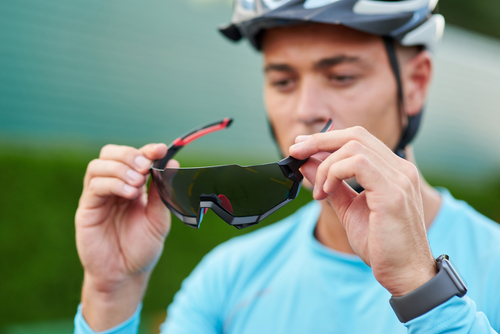
Spring is the perfect time to enjoy the fresh air and get some exercise on the field or court. But as recreation kicks off for the season so do the number of facial and oral injuries being seen by emergency rooms and urgent cares across the country.
Nearly three million people in the U.S. are treated in emergency rooms for facial trauma each year. While many children and their parents are mindful about wearing certain types of protective equipment like bike helmets or shin guards, the face is a vulnerable part of the body that is often neglected. Many of these injuries can be prevented with the proper gear like mouth guards, sports goggles, and fielder’s masks.
“The face is more vulnerable to injury than other parts of the body, so it is important to protect it from trauma. There are many essential sensory organs, all in close proximity, that can get damaged, including the ears, eyes, nose, mouth, and skin,” explains Long Wang, MD, family medicine physician at Summit Health.
Types of Facial Injuries
A traumatic fall or collision can affect any part of the face. Symptoms of a facial injury may include bruising, swelling, bleeding, laceration, and deformity.
In addition to the acute injury, there can be permanent cosmetic damage. For example, scarring on the chin or eyebrow can interfere with lifelong hair growth in that area. Additionally, mouth and dental trauma may compromise how adult teeth come in for young children.
“The most common facial injuries are lacerations and bruises,” says Matthew McCarthy, MD, a pediatric neurologist who specializes in sports neurology and concussion at Summit Health. “Facial bones are also much easier to break than other areas of the body because there is only a thin layer of skin and soft tissue over relatively small and fragile bones.”
Facial injuries often include:
- Lacerations – Deep cuts or tears that often need stitches.
- Contusions – Bruising, typically resulting from a fall or collision with another athlete’s head or elbow.
- Fractures – Bones can break anywhere on the face, most commonly the nose, upper and lower jaw, cheek, or around the eye sockets.
- Eye injuries – Debris may cause penetrating injuries or corneal abrasions that scratch the outer surface of the eye.
- Oral/teeth trauma – Blows to the mouth can knock out or displace teeth.
How Facial Injuries Occur
Children and adults who lead active lifestyles are more likely to get oral or facial injuries. Sports, particularly those that involve heavy contact, and recreational activities like bike riding are leading causes of trauma. Other common ways facial injuries can occur, particularly in adults, include home improvement projects, motor vehicle accidents, falls, and fights.
Tips to Prevent Facial Injuries
“Facial protection simply isn’t mandated in many sports,” says Dr. McCarthy. “No piece of equipment is going to be 100 percent effective at preventing injury, but it can make a big difference. The goal is to decrease or disperse some of the forces to reduce the likelihood and severity of the injury.”
1. Wear Protective Equipment
Both kids and adults who play sports should suit up with face masks, sports goggles, helmets, and mouth guards. Many sports do not require a mouth guard, but it is one of the cheapest and most effective ways to protect yourself from a costly dental injury. Ask your dentist about being fit for a custom mouth guard.
2. Make Sure Your Gear Fits
Using equipment that is the right size and in good working condition is just as important as wearing it. Sometimes athletes who have facial protection get injured because their gear is too big or has been worn down from usage. While football helmets are meant to absorb multiple blows, a bike helmet should be discarded as soon as it takes a hit. Mouth guards also become chewed down over time. Keep an eye on the wear and tear of your equipment.
3. Cover the Eyes
Athletes in many sports like hockey, softball, and lacrosse wear face masks that help protect their eyes. If you do not have a cage on your helmet or use a fielder’s mask, sports goggles are a good alternative. If you or your child has corrective glasses, do not play in them. Regular glasses can break and injure the eye. Prescription sports goggles or contacts are safe alternatives.
4. Wear Your Face Mask
Team sports and activities are one of the most common ways COVID-19 spreads. Facial masks help keep adults and kids safe. They do not affect athletic performance. New research shows that your respiratory rate, oxygen saturation, and time of exhaustion are not significantly impacted by wearing a mask during a moderate to strenuous workout.
5. Do Not Delay Care
When it comes to facial injuries, err on the side of caution. If you are in severe pain, have excessive bleeding or bruising, or a laceration that might need stitches, visit your doctor, or go to urgent care immediately. The longer you wait, the higher risk you have of developing an infection, explains Dr. Wang. He advises that patients with deep cuts flush the wound under tap water, cover it with a bandage, and seek medical attention.
Be a Role Model for Safe Behavior
When it comes to injury prevention, parents and caregivers play a larger role than they may think. Children tend to mimic behaviors they witness – both good and bad. So, as an adult, whether you are riding a bike or participating in a contact sport, it’s critically important to communicate positive safety messages and serve as a model for safe behavior.
“The goal of any sport is for everyone to play for as long as they want with the same healthy body intact,” says Dr. McCarthy. “With simple pieces of equipment and precautions, more facial and oral injuries can be avoided.”
